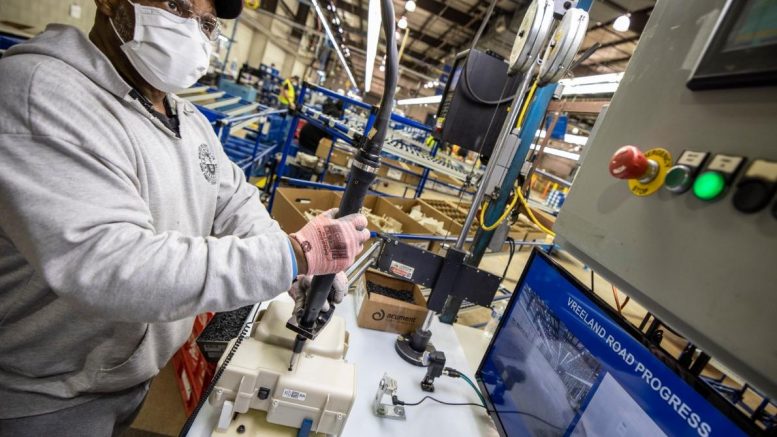Manufacturers that follow CDC guidelines to create a safe and healthy environment for their employees to be able to produce and serve customers are doing the right thing. Plants don’t operate unless operators are kept safe and feel safe coming to work. It is every manufacturer’s responsibility to have a workplace where each worker goes home the same way they came to work: healthy and without injury.

COVID-19
Implementing these guidelines has required changes in how factories operate. Social distancing, new personal protective equipment, and cleaning regimens all have an impact on operations. Some manufacturers have been heard to say, “Our performance is off 20% due to COVID!” Performance may be off 20% because of having to implement these guidelines, but was equipment operating at a high level of operational availability (the combination of the ability to produce good parts and uptime) before COVID-19?
There is no question that new work rules have had an impact on how plants operate. But be objective about one’s operations. Before blaming COVID for poor performance, look at one’s equipment operational availability before COVID-19. Was it above 90%? Above 95%? If operational availability wasn’t this high in January and February 2020, performance was already poor before the coronavirus pandemic.
There is good news. If the plant had poor operational availability before COVID-19, losses due to operating under CDC guidelines can be offset by improving equipment performance. Manufacturers can return to the level of operational results reached at the beginning of 2020 by addressing the root causes of poor operational availability.
James Womack, co-author of the book “Lean Thinking,” shared some insights about operational availability. Jim defined the causes of poor operational availability:
“Low operational availability traces to six types of problems:
- Downtime, when a process won’t run at all (also termed major breakdowns or major stoppages).
- Changeover time, to convert from one product to the next.
- Minor stoppages, of just a few seconds.
- Cycle time fluctuation, when a process takes longer than planned.
- Scrap, meaning some production is lost.
- Rework, in which parts must be run through the process again, reducing the time available for new parts.”

COVID-19
All of these are bad and all should be reduced. But be careful to avoid simple calculations of equipment utilization that confuse availability with uptime. The former is always good: Equipment must be able to run when you need it. The latter can be good or bad: High utilization (uptime) to overproduce items not needed is one of the worst forms of waste. And reducing time lost to changeovers by producing bigger batches rather than by reducing setup times is a big mistake as well.”
Now that our manufacturing plants are operating again, the focus must be on returning to the level of performance prior to COVID without jeopardizing the health and safety of employees. This push for improved operational availability must become the obsession of every manufacturer.
To address the six types of problems will require strong application of Lean principles. Some examples are:
- Respect for standards. Standards must be defined for how to run the equipment and these standards must be respected by every employee, operators and maintainers alike.
- Visual management. Make visible the various operating conditions of the equipment such that when variation increases in how the machine operates it can be immediately detected and addressed before it has negative consequences.
- Waste elimination. Each employee must be continually looking for the seven wastes and acting to eliminate them as soon they are identified.
- Employee engagement. The first three principles are only possible when everyone on the factory floor, from operators to the factory manager, is engaged in making them a reality.
This focus will be necessary to be able to deliver a product that meets the customers specifications for quality, delivery, and to return to a cost that will ensure pre-COVID business results.
Jim Womack concludes, “The most important point is that these problems don’t go away with a bit of random kaizen and they certainly don’t go away if firms are only practicing breakdown maintenance without identifying trends and determining root causes. . . . The challenge is to create a rigorous maintenance process that involves everyone, gathers the appropriate data, discovers the root causes, and installs fixes so known problems don’t recur, and new problems are anticipated (for example, from predictable wear during the equipment’s life cycle).”
The next time someone says, “Our performance is off due to COVID,” challenge them. Don’t blame poor performance on the environment. Focus efforts on what can be controlled. Engage your employees in Lean principles and improve operational availability. Return to the level of performance before COVID-19. Or better yet, exceed it!
–
 About the Author: Mike Ungar is a Certified FocalPoint Business Coach and Trainer. He has 35 years of experience with Michelin in manufacturing and human resources. Mike is a graduate of the United States Military Academy at West Point and the Clemson MBA program.
About the Author: Mike Ungar is a Certified FocalPoint Business Coach and Trainer. He has 35 years of experience with Michelin in manufacturing and human resources. Mike is a graduate of the United States Military Academy at West Point and the Clemson MBA program.




Be the first to comment on "Do not blame COVID-19 for your Poor Performance"